Removal of Heavy Metals (Cd2+, Cu2+, Ni2+, Pb2+) from Aqueous Solution Using Hizikia fusiformis as an Algae-Based Bioadsorbent
Abstract
1. Introduction
2. Materials and Methods
2.1. Bioadsorbent Preparation
2.2. Characterizations
2.3. Batch Biosorption Experiments
2.4. Data Analysis
3. Results and Discussion
3.1. Comparison of Heavy Metal Uptake by Different Algae
3.2. Effect of Acid and Base Treatment on Heavy Metal Removal by H. fusiformis
3.3. Changes in Characteristics of H. fusiformis after Base Treatment
3.4. Biosorption Characteristics of 1 M NaOH-Treated H. fusiformis
3.4.1. Effect of Reaction Time
3.4.2. Effect of Initial Heavy Metal Concentration
3.4.3. Effect of Solution pH
4. Conclusions
Author Contributions
Funding
Institutional Review Board Statement
Informed Consent Statement
Data Availability Statement
Conflicts of Interest
References
- Lakherwal, D. Adsorption of heavy metals: A review. Int. J. Environ. Res. Dev. 2014, 4, 41–48. [Google Scholar]
- Jebasweetly, D.; Sangeetha, K.; Suganthi, B. Biosorption of Heavy Metal Lead from Aqueous Solution by Non-living Biomass of Sargassum myriocystum. Int. J. Appl. Innov. Eng. Manag. 2014, 3, 39–45. [Google Scholar]
- Kumar, K.S.; Dahms, H.U.; Won, E.J.; Lee, J.S.; Shin, K.H. Microalgae—A promising tool for heavy metal remediation. Ecotoxicol. Environ. Saf. 2015, 113, 329–352. [Google Scholar] [CrossRef]
- Iordache, M.; Iordache, A.M.; Sandru, C.; Voica, C.; Zgavarogea, R.; Miricioiu, M.G.; Ionete, R.E. Assessment of heavy metals pollution in sediments from reservoirs of the Olt river as tool for environmental risk management. Rev. Chim. 2019, 70, 4153–4162. [Google Scholar]
- Anastopoulos, I.; Kyzas, G.Z. Progress in batch biosorption of heavy metals onto algae. J. Mol. Liq. 2015, 209, 77–86. [Google Scholar] [CrossRef]
- Saravanan, A.; Brindha, V.; Manimekalai, R.; Krishnan, S. An evaluation of chromium and zinc biosorption by a sea weed (Sargassum sp.) under optimized conditions. Ind. J. Sci. Technol. 2009, 2, 53–56. [Google Scholar] [CrossRef]
- Benzidia, N.; Salhi, A.; Bakkas, S.; Khamliche, L. Biosorption of Copper Cu (II) in aqueous solution by chemically modified crushed marine algae (Bifurcaria bifurcata): Equilibrium and kinetic studies. Mediterran. J. Chem. 2015, 4, 85–92. [Google Scholar] [CrossRef][Green Version]
- Sheth, Y.; Dharaskar, S.; Khalid, M.; Sonawane, S. An environment friendly approach for heavy metal removal from industrial wastewater using chitosan based biosorbent: A review. Sustain. Energy Technol. Assess. 2021, 43, 100951. [Google Scholar] [CrossRef]
- Aung, K.T.; Hong, S.-H.; Park, S.-J.; Lee, C.-G. Removal of Cu(II) from Aqueous Solutions Using Amine-Doped Polyacrylonitrile Fibers. Appl. Sci. 2020, 10, 1738. [Google Scholar] [CrossRef]
- Yang, H.; Kang, J.-K.; Park, S.-J.; Lee, C.-G. Effect of pyrolysis conditions on food waste conversion to biochar as a coagulant aid for wastewater treatment. J. Water Process Eng. 2021, 41, 102081. [Google Scholar] [CrossRef]
- Choi, N.-C.; Cho, K.-H.; Kim, M.-S.; Park, S.-J.; Lee, C.-G. A Hybrid Ion-Exchange Fabric/Ceramic Membrane System to Remove As(V), Zn(II), and Turbidity from Wastewater. Appl. Sci. 2020, 10, 2414. [Google Scholar] [CrossRef]
- Fu, F.; Wang, Q. Removal of heavy metal ions from wastewaters: A review. J. Environ. Manag. 2011, 92, 407–418. [Google Scholar] [CrossRef]
- Boni, M.R.; Chiavola, A.; Marzeddu, S. Remediation of Lead-Contaminated Water by Virgin Coniferous Wood Biochar Adsorbent: Batch and Column Application. Water Air Soil Pollut. 2020, 231, 171. [Google Scholar] [CrossRef]
- Ya, V.; Martin, N.; Chou, Y.-H.; Chen, Y.-M.; Choo, K.-H.; Chen, S.-S.; Li, C.-W. Electrochemical treatment for simultaneous removal of heavy metals and organics from surface finishing wastewater using sacrificial iron anode. J. Taiwan Inst. Chem. Eng. 2018, 83, 107–114. [Google Scholar] [CrossRef]
- Munoz, A.J.; Espınola, F.; Ruiz, E. Removal of Pb(II) in a packed-bed column by a Klebsiella sp. 3S1 biofilm supported on porous ceramic Raschig rings. J. Indus. Eng. Chem. 2016, 40, 118–127. [Google Scholar] [CrossRef]
- Verma, A.; Kumar, S.; Kumar, S. Biosorption of lead ions from the aqueous solution by Sargassum filipendula: Equilibrium and kinetic studies. J. Environ. Chem. Eng. 2016, 4, 4587–4599. [Google Scholar] [CrossRef]
- Matei, G.M.; Kiptoo, J.K.; Oyaro, N.K.; Onditi, A.O. Biosorption of selected heavy metals by the biomass of the green alga Spirogyra sp. Phys. Chem. Technol. J. 2014, 12, 22–34. [Google Scholar] [CrossRef]
- Kanchana, S.; Jeyanthi, J.; Kathiravan, R.; Suganya, K. Biosorption of heavy metals using algae: A review. Int. J. Pharm. Med. Biol. Sci. 2014, 3, 1–9. [Google Scholar]
- Quansah, J.O.; Hlaing, T.; Lyonga, F.N.; Kyi, P.P.; Hong, S.-H.; Lee, C.-G.; Park, S.-J. Nascent rice husk as an adsorbent for removing cationic dyes from textile wastewater. Appl. Sci. 2020, 10, 3437. [Google Scholar] [CrossRef]
- Kyi, P.P.; Quansah, J.O.; Lee, C.-G.; Moon, J.-K.; Park, S.-J. The removal of crystal violet from textile wastewater using palm kernel shell-derived biochar. Appl. Sci. 2020, 10, 2251. [Google Scholar] [CrossRef]
- Hong, S.H.; Shin, M.C.; Lee, J.; Lee, C.G.; Song, D.S.; Um, B.H.; Park, S.J. Recycling of bottom ash derived from combustion of cattle manure and its adsorption behaviors for Cd(II), Cu(II), Pb(II), and Ni(II). Environ. Sci. Pollut. Res. Int. 2021, 28, 14957–14968. [Google Scholar] [CrossRef]
- Niculescu, V.-C.; Miricioiu, M.G.; Ionete, R.-E. Nanomaterials and Their Role in Removing Contaminants from Wastewater—A Critical Review. Water Saf. Secur. Sustain. 2021, 135–159. [Google Scholar] [CrossRef]
- Wang, L.; Tay, J.; Tay, S.; Hung, Y. Heavy Metal Removal by Microbial Biosorbents. In Environmental Bioengineering; Humana Press: Totowa, NJ, USA, 2010; Volume 11, pp. 375–402. [Google Scholar]
- Brinza, L.; Dring, M.J.; Gavrilescu, M. Marine microalgal species as biosorbents for heavy metals. Environ. Eng. Manag. J. 2007, 6, 237–251. [Google Scholar] [CrossRef]
- Sulaymon, A.H.; Mohammed, A.; Al-Musawi, T. Column biosorption of lead, cadmium, copper, and arsenic ions onto algae. J. Bioproces Biotechniq. 2013, 3, 128. [Google Scholar] [CrossRef]
- Brinza, L.; Nygård, C.A.; Dring, M.J.; Gavrilescu, M.; Benning, L.G. Cadmium tolerance and adsorption by the marine brown alga Fucus vesiculosus from the Irish Sea and the Bothnian Sea. Bioresour. Technol. 2009, 100, 1727–1733. [Google Scholar] [CrossRef] [PubMed]
- Quari, H.A.; Hassan, I.A. Removal of pollutants from wastewater using Dunaliella algae. Biomed. Pharma. J. 2014, 7, 147–151. [Google Scholar] [CrossRef]
- Utomo, H.D.; Tan, K.X.D.; Choong, Z.Y.D.; Yu, J.J.; Ong, J.J.; Lim, Z.B. Biosorption of Heavy Metal by Algae Biomass in Surface Water. J. Environ. Protect. 2016, 7, 1547–1560. [Google Scholar] [CrossRef]
- Ali, A.; Shah, Z.; Hussain, A.; Shafi, I.; Ali, M.; Abbas, A. Removal of heavy metals (Cr, Cd, Ni and Pb) using fresh water algae (Utricularia tenuissima, Utricularia tenuis & Zygogonium ericetorum) from contaminated water. J. Biol. Environ. Sci. 2015, 6, 358–366. [Google Scholar]
- Davis, T.A.; Volesky, B.; Mucci, A. A review of the biochemistry of heavy metal biosorption by brown algae. Water Res. 2003, 37, 4311–4330. [Google Scholar] [CrossRef]
- He, J.; Chen, J.P. A comprehensive review on biosorption of heavy metals by algal biomass: Materials, performances, chemistry, and modeling simulation tools. Bioresour. Technol. 2014, 160, 67–78. [Google Scholar] [CrossRef]
- Akbari, M.; Hallajisani, A.; Keshtkar, A.R.; Shahbeig, H.; Ali Ghorbanian, S. Equilibrium and kinetic study and modeling of Cu(II) and Co(II) synergistic biosorption from Cu(II)-Co(II) single and binary mixtures on brown algae C. indica. J. Environ. Chem. Eng. 2015, 3, 140–149. [Google Scholar] [CrossRef]
- Lagergren, S.K. About the theory of so-called adsorption of soluble substances. Sven. Vetenskapsakad. Handingarl 1898, 24, 1–39. [Google Scholar]
- Blanchard, G.; Maunaye, M.; Martin, G. Removal of heavy metals from waters by means of natural zeolites. Water Res. 1984, 18, 1501–1507. [Google Scholar] [CrossRef]
- Roginsky, S.; Zeldovich, Y.B. The catalytic oxidation of carbon monoxide on manganese dioxide. Acta Phys. Chem. USSR 1934, 1, 2019. [Google Scholar]
- Weber Jr, W.J.; Morris, J.C. Kinetics of adsorption on carbon from solution. J. Sanit. Eng. Div. 1963, 89, 31–59. [Google Scholar] [CrossRef]
- Oves, M.; Khan, M.S.; Zaidi, A. Biosorption of heavy metals by Bacillus thuringiensis strain OSM29 originating from industrial effluent contaminated north Indian soil. Saudi J. Biol. Sci. 2013, 20, 121–129. [Google Scholar] [CrossRef] [PubMed]
- Çetinkaya Dönmez, G.; Aksu, Z.; Öztürk, A.; Kutsal, T. A comparative study on heavy metal biosorption characteristics of some algae. Process Biochem. 1999, 34, 885–892. [Google Scholar] [CrossRef]
- Galun, M.; Galun, E.; Siegel, B.Z.; Keller, P.; Lehr, H.; Siegel, S.M. Removal of metal ions from aqueous solutions by Penicillium biomass: Kinetic and uptake parameters. Water Air Soil Pollut. 1987, 33, 359–371. [Google Scholar] [CrossRef]
- Chen, J.P.; Yang, L. Chemical Modification of Sargassum sp. for Prevention of Organic Leaching and Enhancement of Uptake during Metal Biosorption. Ind. Eng. Chem. Res. 2005, 44, 9931–9942. [Google Scholar] [CrossRef]
- Gupta, V.K.; Rastogi, A. Biosorption of lead from aqueous solutions by green algae Spirogyra species: Kinetics and equilibrium studies. J. Hazard. Mater. 2008, 152, 407–414. [Google Scholar] [CrossRef] [PubMed]
- Feng, N.-c.; Guo, X.-y. Characterization of adsorptive capacity and mechanisms on adsorption of copper, lead and zinc by modified orange peel. Trans. Nonferrous Met. Soc. China 2012, 22, 1224–1231. [Google Scholar] [CrossRef]
- Ibrahim, W.M.; Hassan, A.F.; Azab, Y.A. Biosorption of toxic heavy metals from aqueous solution by Ulva lactuca activated carbon. Egypt. J. Basic Appl. Sci. 2016, 3, 241–249. [Google Scholar] [CrossRef]
- Villaescusa, I.; Fiol, N.; Martínez, M.a.; Miralles, N.; Poch, J.; Serarols, J. Removal of copper and nickel ions from aqueous solutions by grape stalks wastes. Water Res. 2004, 38, 992–1002. [Google Scholar] [CrossRef]
- Shin, W.-S.; Kim, Y.-K. Biosorption characteristics of heavy metals (Ni2+, Zn2+, Cd2+, Pb2+) from aqueous solution by Hizikia fusiformis. Environ. Earth Sci. 2014, 71, 4107–4114. [Google Scholar] [CrossRef]
- Harris, P.O.; Ramelow, G.J. Binding of metal ions by particulate biomass derived from Chlorella vulgaris and Scenedesmus quadricauda. Environ. Sci. Technol. 1990, 24, 220–228. [Google Scholar] [CrossRef]
- Matheickal, J.T.; Yu, Q.; Woodburn, G.M. Biosorption of cadmium(II) from aqueous solutions by pre-treated biomass of marine alga DurvillAea potatorum. Water Res. 1999, 33, 335–342. [Google Scholar] [CrossRef]
- Wasewar, K.L.; Prasad, B.; Gulipalli, S. Adsorption of Selenium Using Bagasse Fly Ash. CLEAN Soil Air Water 2009, 37, 534–543. [Google Scholar] [CrossRef]
- Hong, S.-H.; Lyonga, F.N.; Kang, J.-K.; Seo, E.-J.; Lee, C.-G.; Jeong, S.; Hong, S.-G.; Park, S.-J. Synthesis of Fe-impregnated biochar from food waste for Selenium(VI) removal from aqueous solution through adsorption: Process optimization and assessment. Chemosphere 2020, 252, 126475. [Google Scholar] [CrossRef]
- Wu, F.-C.; Tseng, R.-L.; Juang, R.-S. Initial behavior of intraparticle diffusion model used in the description of adsorption kinetics. Chem. Eng. J. 2009, 153, 1–8. [Google Scholar] [CrossRef]
- Kumari, H.J.; Krishnamoorthy, P.; Arumugam, T.; Radhakrishnan, S.; Vasudevan, D. An efficient removal of crystal violet dye from waste water by adsorption onto TLAC/Chitosan composite: A novel low cost adsorbent. Int. J. Biol. Macromol. 2017, 96, 324–333. [Google Scholar] [CrossRef] [PubMed]
- Hong, S.-H.; Park, S.-J. Removal of Cd2+, Cu2+, Pb2+, Ni2+ in Aqueous Solution by Thermally Treated Sepiolite. J. Korean Soc. Environ. Eng. 2019, 41, 372–380. [Google Scholar] [CrossRef]
- Park, S.J.; Kang, K.; Lee, C.G.; Choi, J.W. Remediation of metal-contaminated marine sediments using active capping with limestone, steel slag, and activated carbon: A laboratory experiment. Environ. Technol. 2019, 40, 3479–3491. [Google Scholar] [CrossRef] [PubMed]
- McBride, M.B. Environmental Chemistry of Soils; Oxford University Press: England, UK, 1994. [Google Scholar]
- Shi, T.; Jia, S.; Chen, Y.; Wen, Y.; Du, C.; Guo, H.; Wang, Z. Adsorption of Pb(II), Cr(III), Cu(II), Cd(II) and Ni(II) onto a vanadium mine tailing from aqueous solution. J. Hazard. Mater. 2009, 169, 838–846. [Google Scholar] [CrossRef] [PubMed]
- Romera, E.; González, F.; Ballester, A.; Blázquez, M.L.; Muñoz, J.A. Comparative study of biosorption of heavy metals using different types of algae. Bioresour. Technol. 2007, 98, 3344–3353. [Google Scholar] [CrossRef]
- Alloway, B.J. Soil Processes and The Behaviour of Metals; Glasgow G64 2NZ; Blackie & Son Ltd.: Bishopbriggs, Scotland, 1990; pp. 7–28. [Google Scholar]
- Kang, K.; Lee, C.-G.; Choi, J.-W.; Kim, Y.-K.; Park, S.-J. Evaluation of the Use of Sea Sand, Crushed Concrete, and Bentonite to Stabilize Trace Metals and to Interrupt Their Release from Contaminated Marine Sediments. Water Air Soil Pollut. 2016, 227, 308. [Google Scholar] [CrossRef]
- Mazur, L.P.; Cechinel, M.A.P.; de Souza, S.M.A.G.U.; Boaventura, R.A.R.; Vilar, V.J.P. Brown marine macroalgae as natural cation exchangers for toxic metal removal from industrial wastewaters: A review. J. Environ. Manag. 2018, 223, 215–253. [Google Scholar] [CrossRef]
- Yahaya, Y.A.; Don, M.M. Pycnoporus sanguineus as potential biosorbent for heavy metal removal from aqueous solution: A review. J. Phys. Sci. 2014, 25, 1. [Google Scholar]
- Apiratikul, R.; Pavasant, P. Batch and column studies of biosorption of heavy metals by Caulerpa lentillifera. Bioresour. Technol. 2008, 99, 2766–2777. [Google Scholar] [CrossRef]
- Prasher, S.O.; Beaugeard, M.; Hawari, J.; Bera, P.; Patel, R.M.; Kim, S.H. Biosorption of Heavy Metals by Red Algae (Palmaria palmata). Environ. Technol. 2004, 25, 1097–1106. [Google Scholar] [CrossRef]
- Lu, D.; Cao, Q.; Li, X.; Cao, X.; Luo, F.; Shao, W. Kinetics and equilibrium of Cu(II) adsorption onto chemically modified orange peel cellulose biosorbents. Hydrometallurgy 2009, 95, 145–152. [Google Scholar] [CrossRef]
- Jin, X.; Yu, C.; Li, Y.; Qi, Y.; Yang, L.; Zhao, G.; Hu, H. Preparation of novel nano-adsorbent based on organic-inorganic hybrid and their adsorption for heavy metals and organic pollutants presented in water environment. J. Hazard. Mater. 2011, 186, 1672–1680. [Google Scholar] [CrossRef]
- Phoochinda, W.; White, D.A. Removal of algae using froth flotation. Environ. Technol. 2003, 24, 87–96. [Google Scholar] [CrossRef] [PubMed]
- Bampaiti, A.; Yusan, S.; Aytas, S.; Pavlidou, E.; Noli, F. Investigation of uranium biosorption from aqueous solutions by Dictyopteris polypodioides brown algae. J. Radioanal. Nucl. Chem. 2016, 307, 1335–1343. [Google Scholar] [CrossRef]
- Mokhtar, N.; Aziz, E.A.; Aris, A.; Ishak, W.F.W.; Mohd Ali, N.S. Biosorption of azo-dye using marine macro-alga of Euchema Spinosum. J. Environ. Chem. Eng. 2017, 5, 5721–5731. [Google Scholar] [CrossRef]
- Bakatula, E.N.; Richard, D.; Neculita, C.M.; Zagury, G.J. Determination of point of zero charge of natural organic materials. Environ. Sci. Pollut. Res. 2018, 25, 7823–7833. [Google Scholar] [CrossRef]
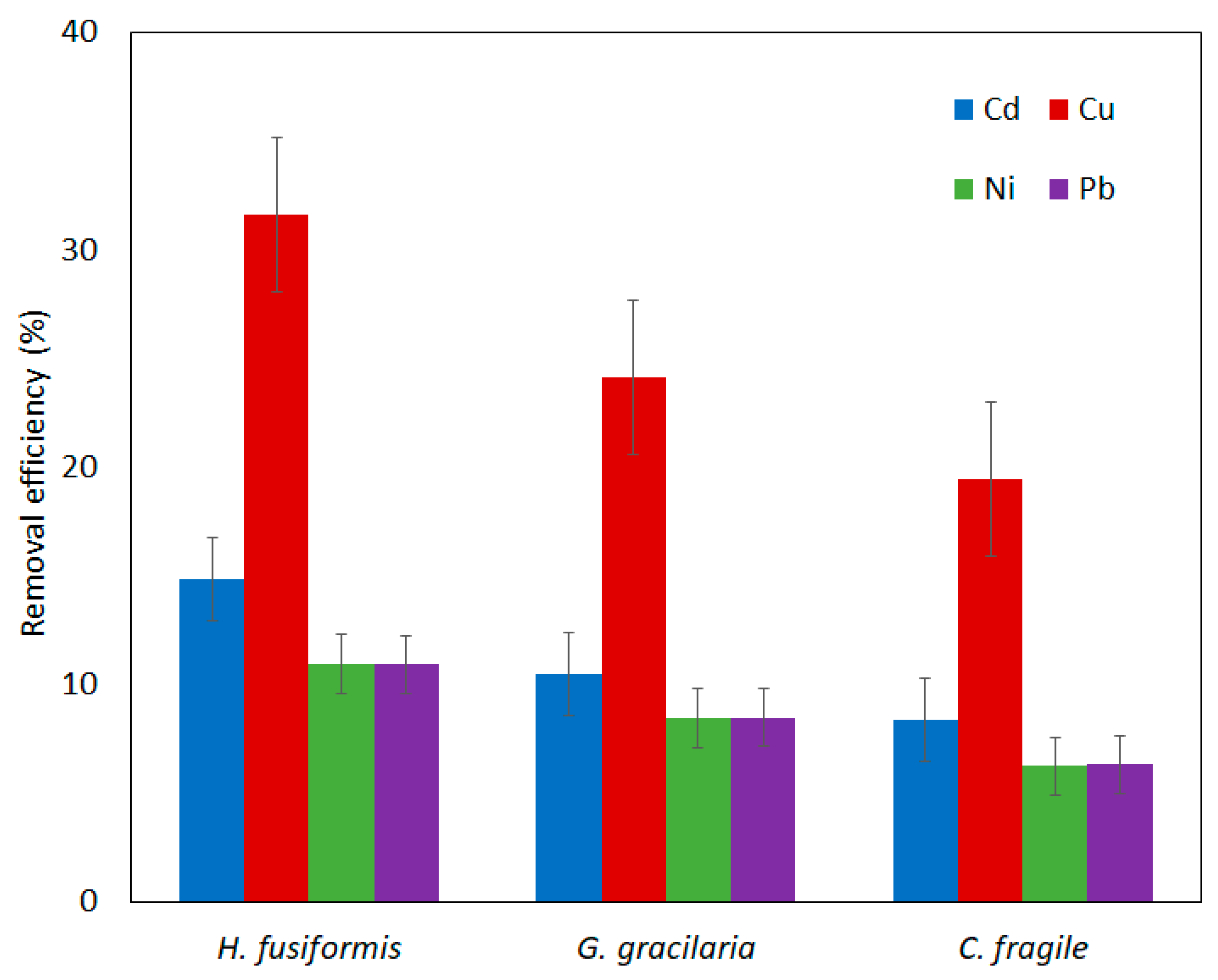
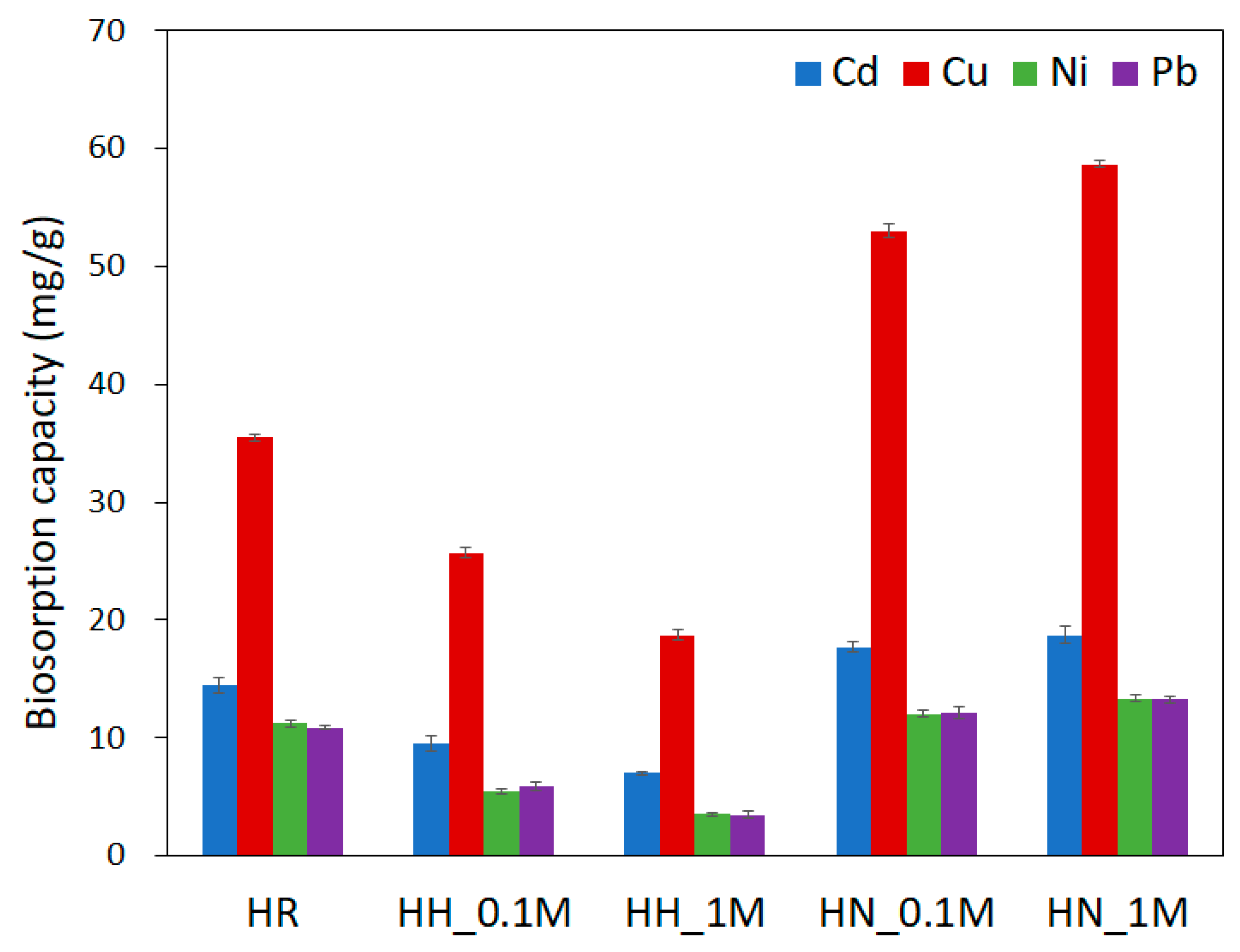
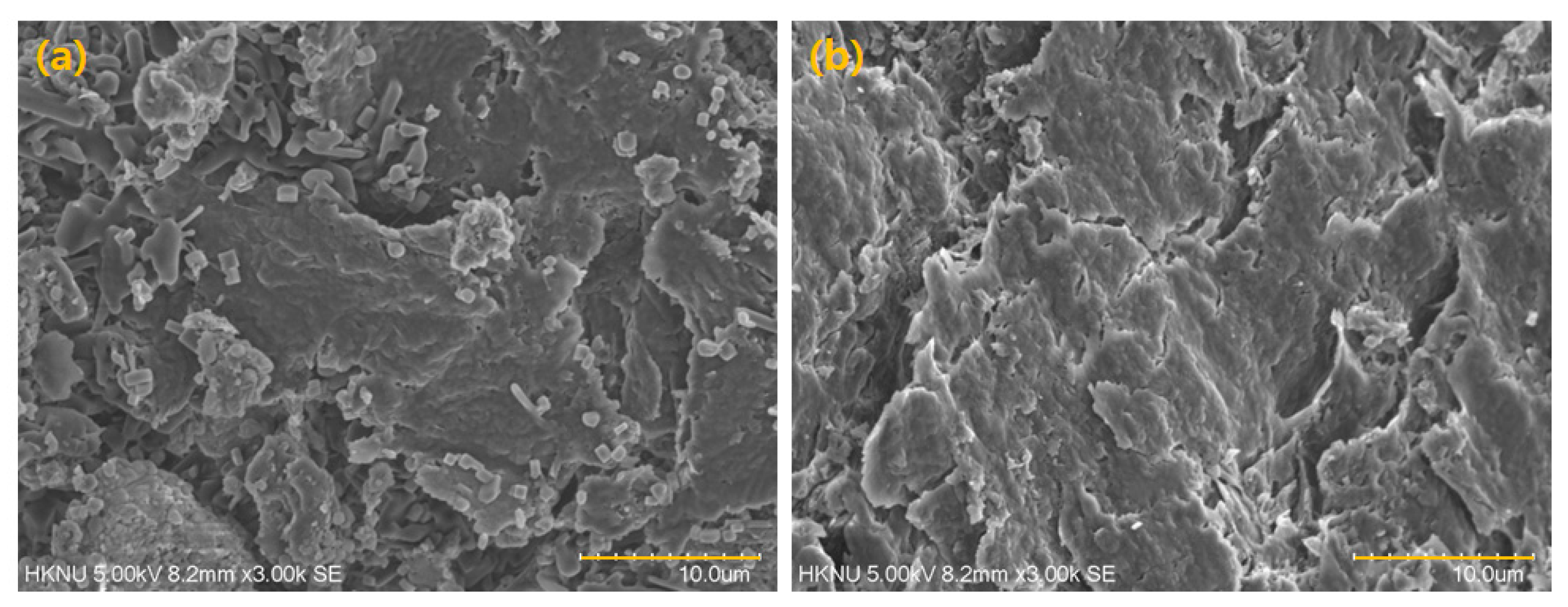
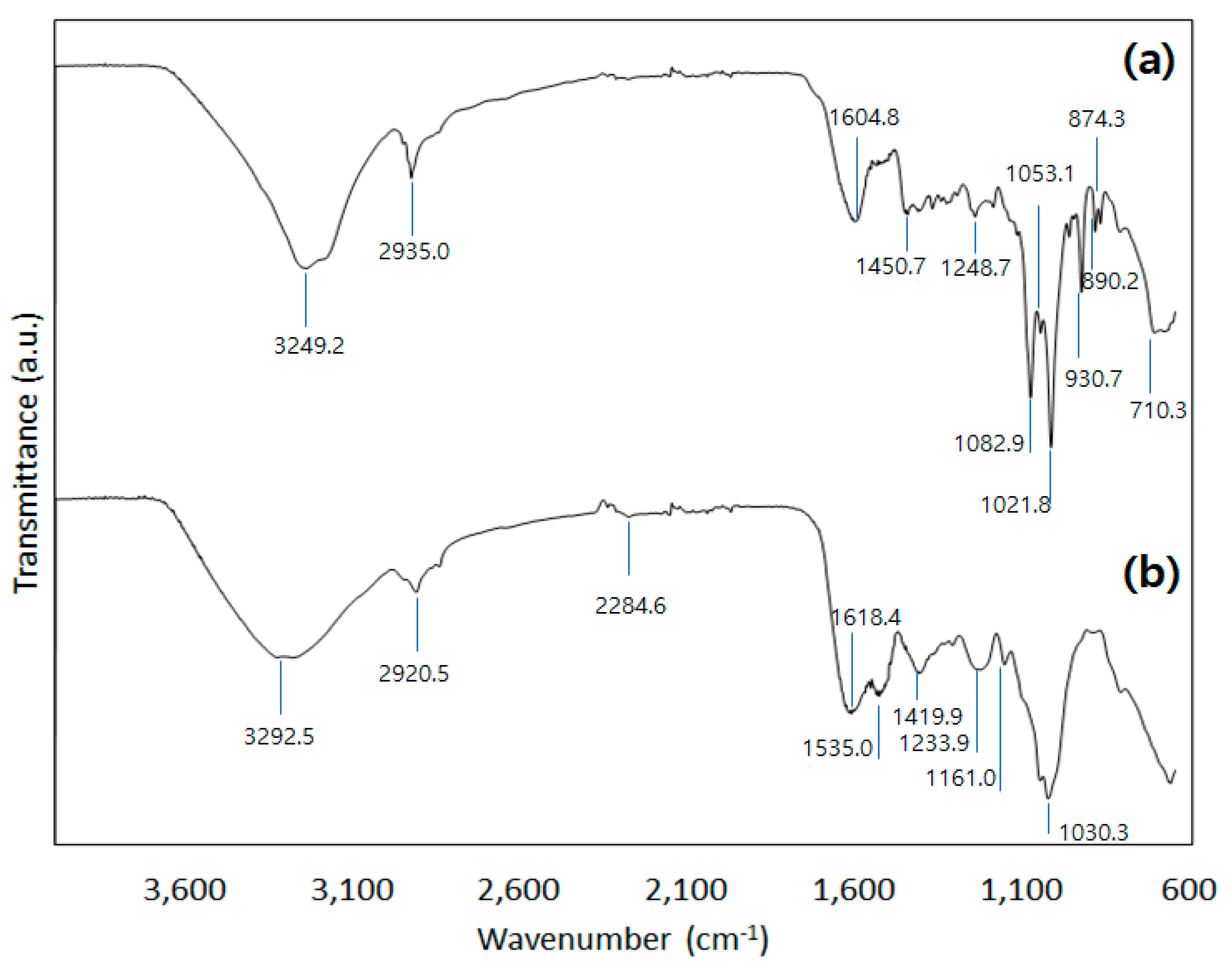
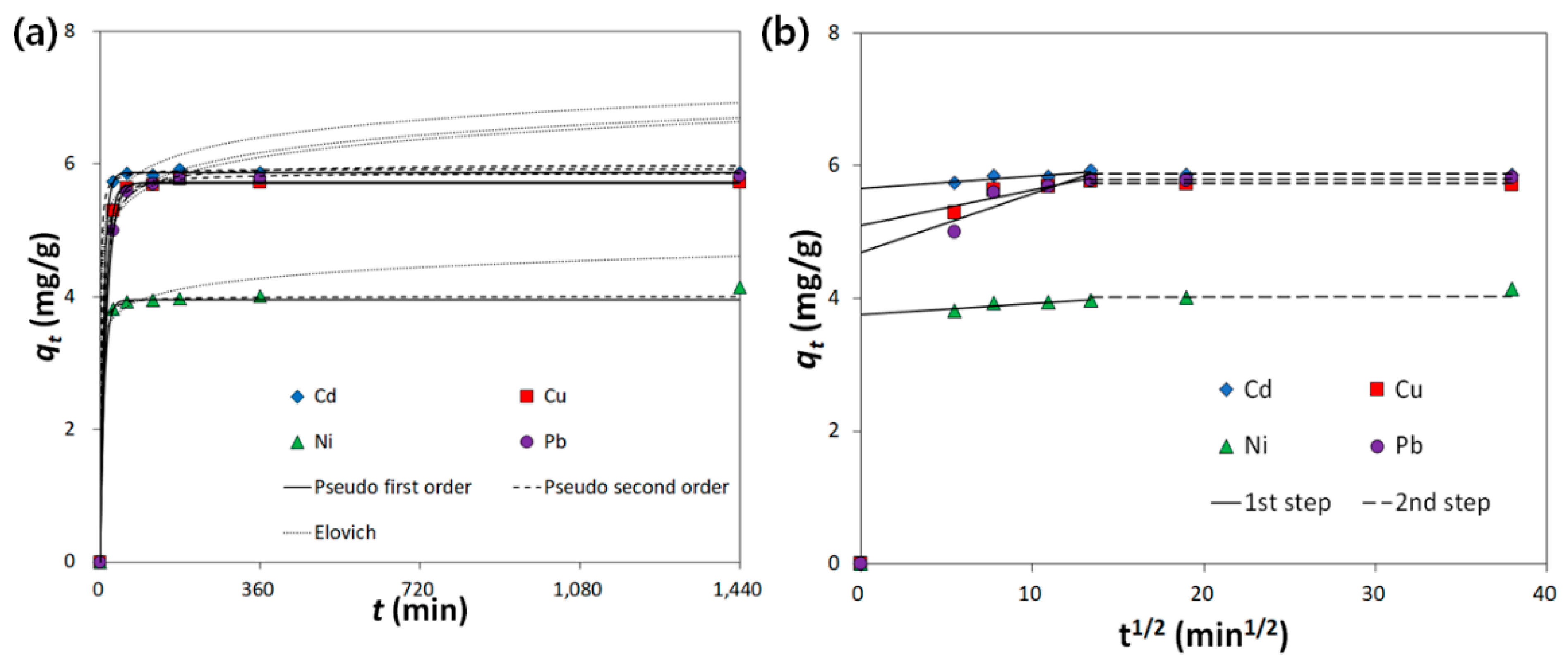
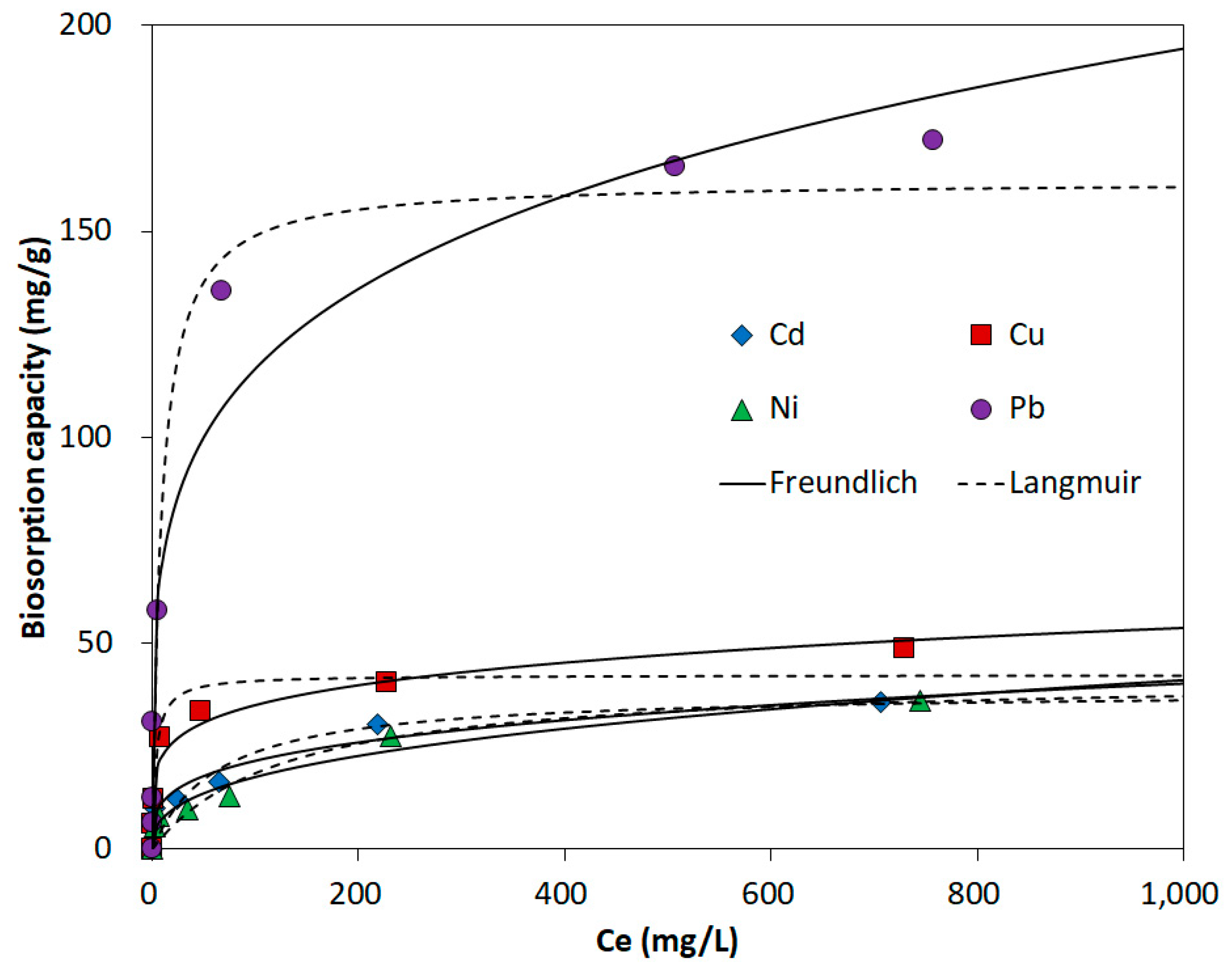
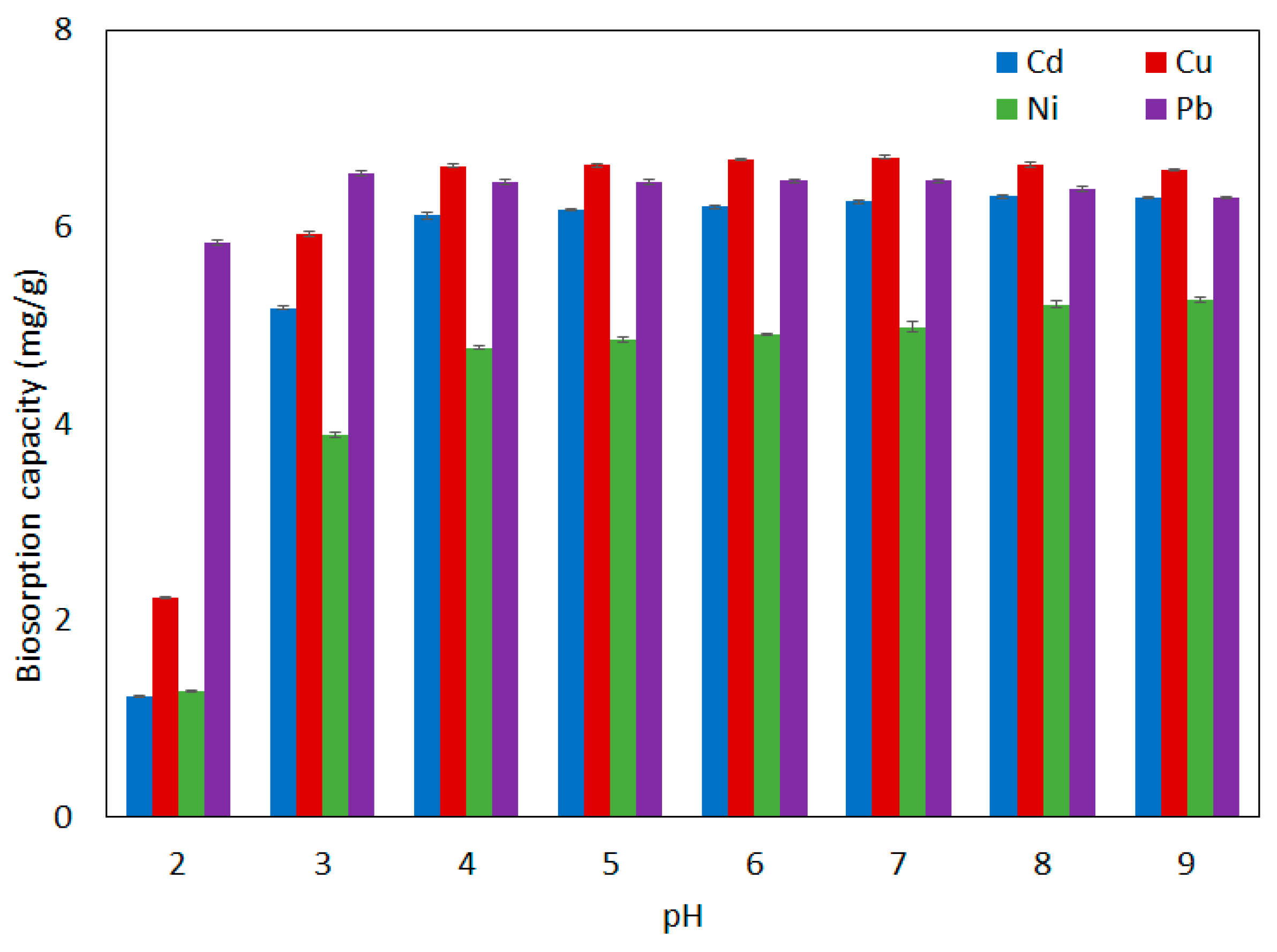
| Biomass | Untreated | NaOH 0.1 M | NaOH 1 M | HCl 0.1 M | HCl 1 M |
| H. fusiformis | HR | HN_0.1 M | HN_1 M | HH_0.1 M | HH_1 M |
| Metals | Pseudo-First-Order Model | Pseudo-Second-Order Model | Elovich Model | |||||||||
|---|---|---|---|---|---|---|---|---|---|---|---|---|
| qe (mg/g) | k1 (1/min) | R2 | SSE | qe (mg/g) | k2 (g/mg‧min) | R2 | SSE | α (mg/g/min) | β (g/mg) | R2 | SSE | |
| Cd2+ | 5.869 | 0.126 | 1.000 | 0.004 | 5.924 | 0.175 | 1.000 | 0.004 | 2.30 × 104 | 2.640 | 0.994 | 0.164 |
| Cu2+ | 5.709 | 0.087 | 1.000 | 0.006 | 5.870 | 0.055 | 1.000 | 0.004 | 1.15 × 104 | 2.625 | 0.998 | 0.049 |
| Ni2+ | 3.952 | 0.112 | 1.000 | 0.001 | 4.005 | 0.173 | 1.000 | 0.000 | 4.05 × 104 | 4.191 | 0.996 | 0.048 |
| Pb2+ | 5.726 | 0.069 | 1.000 | 0.006 | 5.996 | 0.030 | 0.999 | 0.016 | 8.21 × 103 | 2.598 | 0.998 | 0.056 |
| Metals | Intraparticle Diffusion Model–1st Step | Intraparticle Diffusion Model–2nd Step | ||||||
|---|---|---|---|---|---|---|---|---|
| ki (g/mg/min0.5) | C (mg/g) | R2 | SSE | ki (g/mg/min0.5) | C (mg/g) | R2 | SSE | |
| Cd2+ | 0.0490 | 5.816 | 0.999 | 0.019 | 0.0001 | 6.401 | 1.000 | 0.001 |
| Cu2+ | 0.0573 | 5.923 | 1.000 | 0.011 | 0.0001 | 6.657 | 1.000 | 0.000 |
| Ni2+ | 0.0147 | 5.737 | 1.000 | 0.001 | 0.0001 | 5.889 | 0.997 | 0.006 |
| Pb2+ | 0.0276 | 2.352 | 0.988 | 0.285 | 0.0001 | 5.810 | 1.000 | 0.002 |
| Metals | Langmuir Model | Freundlich Model | ||||||
|---|---|---|---|---|---|---|---|---|
| qm (mg/g) | KL (L/mg) | R2 | SSE | KF ((mg/g)∙(L/mg)1/n) | 1/n | R2 | SSE | |
| Cd2+ | 38.390 | 0.0158 | 0.882 | 118.0 | 6.127 | 0.272 | 0.965 | 34.5 |
| Cu2+ | 42.250 | 0.2879 | 0.952 | 96.0 | 14.844 | 0.186 | 0.956 | 88.3 |
| Ni2+ | 41.872 | 0.0079 | 0.933 | 66.0 | 3.198 | 0.369 | 0.970 | 29.5 |
| Pb2+ | 162.201 | 0.1127 | 0.967 | 1054.9 | 42.060 | 0.222 | 0.950 | 1382.9 |
| Adsorbents | Pb2+ (mg/g) | Cu2+ (mg/g) | Cd2+ (mg/g) | Ni2+ (mg/g) | References |
|---|---|---|---|---|---|
| Asparagpsis armata | 63.7 | 21.3 | 32.3 | 17.1 | [56] |
| Spirogyra insignis | 51.5 | 19.3 | 22.9 | 17.5 | [56] |
| Fucus spiralis | 204.1 | 70.9 | 114.9 | 50.0 | [56] |
| Codium vermilara | 63.3 | 16.9 | 21.8 | 13.2 | [60] |
| Chondrus crispus | 204.1 | 40.5 | 75.2 | 37.2 | [60] |
| Ascophyllum nodosum | 178.6 | 58.8 | 87.7 | 43.3 | [60] |
| Caulerpa lentillifera | 28.98 | 8.26 | 4.70 | - | [61] |
| P. palmata | 15.17 | 6.65 | - | - | [62] |
| H. fusiformis | 162.20 | 42.25 | 38.39 | 41.87 | This study |
Publisher’s Note: MDPI stays neutral with regard to jurisdictional claims in published maps and institutional affiliations. |
© 2021 by the authors. Licensee MDPI, Basel, Switzerland. This article is an open access article distributed under the terms and conditions of the Creative Commons Attribution (CC BY) license (https://creativecommons.org/licenses/by/4.0/).
Share and Cite
Pham, B.N.; Kang, J.-K.; Lee, C.-G.; Park, S.-J. Removal of Heavy Metals (Cd2+, Cu2+, Ni2+, Pb2+) from Aqueous Solution Using Hizikia fusiformis as an Algae-Based Bioadsorbent. Appl. Sci. 2021, 11, 8604. https://doi.org/10.3390/app11188604
Pham BN, Kang J-K, Lee C-G, Park S-J. Removal of Heavy Metals (Cd2+, Cu2+, Ni2+, Pb2+) from Aqueous Solution Using Hizikia fusiformis as an Algae-Based Bioadsorbent. Applied Sciences. 2021; 11(18):8604. https://doi.org/10.3390/app11188604
Chicago/Turabian StylePham, Bich Ngoc, Jin-Kyu Kang, Chang-Gu Lee, and Seong-Jik Park. 2021. "Removal of Heavy Metals (Cd2+, Cu2+, Ni2+, Pb2+) from Aqueous Solution Using Hizikia fusiformis as an Algae-Based Bioadsorbent" Applied Sciences 11, no. 18: 8604. https://doi.org/10.3390/app11188604
APA StylePham, B. N., Kang, J.-K., Lee, C.-G., & Park, S.-J. (2021). Removal of Heavy Metals (Cd2+, Cu2+, Ni2+, Pb2+) from Aqueous Solution Using Hizikia fusiformis as an Algae-Based Bioadsorbent. Applied Sciences, 11(18), 8604. https://doi.org/10.3390/app11188604








